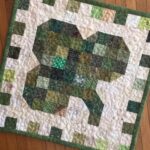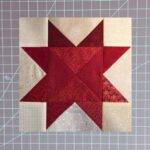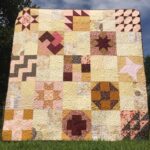In just a few hours you can make this easy and adorable Pillow Talk throw pillow pattern!!
If you’re looking for adding a little pop of color to your bed pillows or couch the adorable words and heart in this easy throw pillow pattern will do the trick!
This beginner quilt pattern will let you try your hand at patchwork without the commitment of a large project.
Easy patchwork squares and blocks come together to make this simple patchwork pillow. Make it as a homemade gift for yourself or your Valentine!
If you don’t want to make this beautiful mini quilt top into a pillow you can easily bind it. Use this little quilt as a table runner or wall hanging instead of a pillow to finish the project even quicker!!
I’ll include easy steps to make both the pillow and the mini quilt so you can make either or both!
Let’s get started!!
Post contains affiliate links and we earn commissions if you shop through the links on this page, including Amazon Associate links. For more information please read the disclaimer on the Privacy Policy page.
Fabric Requirements to Make the Pillow Talk Throw Pillow Pattern
This easy quilt pattern uses very little fabric! I made my pillow just out of scraps from my fabric stash!!
But if you don’t have 100% quilt fabric on hand you can purchase the follow yardages. Visit your local quilt shop to obtain the fabrics needed to make this fun quilt project!
Gray fabric for the letters requires about 1/8 yard.
Pink fabric for the heart also requires about 1/8 yard.
The white background fabric used in this throw pillow pattern requires about 1/2 yard of fabric.
For the backing fabric and the backing for the quilted pillow top you’ll need 1/2 yard of each, or 1 yard total.
If you’re going to make a mini quilt instead of a quilted pillow you’ll also need about 1/4 yard of fabric for the binding.
And you’ll also need a 16” x 37” piece of thin cotton batting for either the pillow or the quilt.
For the pillow you’ll need a small bag of polyester fiber fill stuffing. Or…you can recycle stuffing from an old bed pillow!
And you’ll need a hand-stitching needle.
Cutting Directions for Making the Pillow Talk Throw Pillow Pattern
Use your favorite rotary cutter, plastic quilt ruler, cutting mat, fabric scissors, pins, and thread to make this fun quilt project!

Gray Lettering Fabric
Cut 34 – 2” x 2” squares.
Pink Heart Fabric
Cut 14 – 2” x 2” squares.
White Background Fabric
Cut the following:
4 – 1 1/4″ x 1 1/4″ squares
2 – 1 1/4″ x 2” squares
12 – 2” x 2” squares
2 – 2” x 3 1/2″squares
1 – 2” x 5” strip
5 – 2” x 6 1/2″ strips
1 – 3 1/2″ x 5” strip
Top and Bottom Border Fabric
Cut 2 – 3 1/2″ x 33 1/2″ strips.
Backing Fabric for Quilt Top and Pillow Back
Cut 1 – 16” x 37” piece and 1 – 12 1/2″ x 33 1/2″ piece.
I used a plain white for the back of the quilted pillow top (the larger piece) and a pretty gray with pink flowers for the back of the pillow itself (the smaller piece).

Batting
Cut 1 – 16” x 37” piece.
Binding (if making a quilt instead of a pillow)
Cut 3 – 2 1/2″ x width of fabric (WOF) strips.
General Directions for Making the Pillow Talk Throw Pillow Pattern
The directions for this quilted pillow are for rotary cutting, machine piecing, and machine quilting. If you’re making just a quilt instead of a pillow the binding is hand-stitched to the quilt back.
Accurate cutting and sewing enhances your final product. Pin your pieces together before sewing them to ensure proper seam alignment.
Use a 1/4″ seam allowance. I recommend using a special presser foot with a 1/4″ guide if you have one for your machine. This will help you get uniform seams, and matching corners!
Follow the directions described below as you press the seams. Each individual row or unit is pressed in a specific direction to help eliminate bulk and help seams to lay flat.
Sewing the Letter Blocks for the Pillow Talk Throw Pillow Pattern
It’s so easy to make each of these L O V and E letters and the heart for the cozy pillow top!

Make the Heart Block
For the heart block you’ll need 14 – 2” x 2” pink squares, 4 – 1 1/4″ x 1 1/4″ white squares, 6 – 2” x 2” white squares, and 1 – 2” x 6 1/2″ white strip.
Arrange the patches into the block layout.

Use a thin pencil to draw a diagonal line on the back side of each of the white squares.
Right sides together sew a 2” white square to a pink square along the line you just drew.
Trim 1/4″ from the seam and press the half square triangle (HST) block you just made toward the pink fabric.



These will be the HST for the bottom of the heart.
Right sides together sew a 1 1/4″ white square to the upper left corner of two pink squares and to the upper right corner of two other pink squares.


Trim 1/4″ from the seam and press seam toward the pink fabric.

These will be the blocks for the top of the heart.
Place the HST and the top white/pink blocks to form the shape of the heart again.

Sew the top four pink blocks, the pink squares, the HST and pink squares, and the white squares and HST to form four rows of the heart.

Press the top and third rows to the right and press the second and bottom rows to the left.

Sew the rows together. Press seams downward.
Sew the white strip to the right side of the heart to finish the block.



Press seam toward white strip.

Make the L Block
For the L block you’ll need 6 – 2” x 2” gray squares, 2 – 2” x 6 1/2″ strips, and 1 – 3 1/2″ x 5” strip.
Arrange the patches into the block layout.

Sew together four gray squares into a vertical row. Press seams down.
Pin and sew a 2” strip onto the left side of the row. Press seam toward white strip.
Sew the bottom two gray squares together. Press seams to the right.
Pin and sew the large white strip to the top of them. Press the seam upward.


Then sew another 2” strip to the right side. Press seam toward white strip.

Sew the two units together to finish the block. Press seam toward large white piece.

Make the O Block
For the O block you’ll need 10 – 2” x 2” gray squares, 4 – 2” x 2” white squares, and 1 – 2” x 3 1/2″ white strip.
Arrange the patches into the block layout.

Use a thin pencil to draw a diagonal line on the back side of each of the white squares.
Right sides together sew a gray square to a white square along the line you just drew.
Trim 1/4″ from the seam and press the half square triangle (HST) block you just made toward the gray fabric.
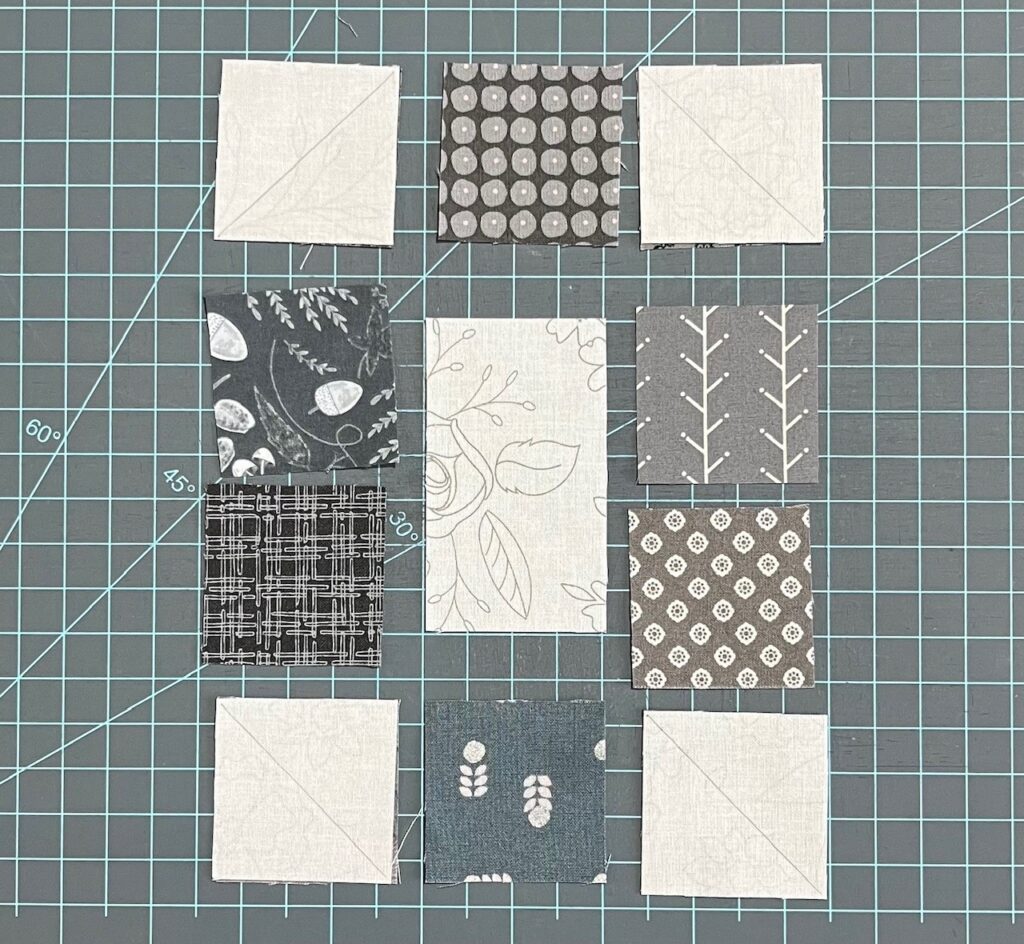

Now you’ll sew the block into three rows.
Sew a HST to the left and right sides of a gray square to form the top row. Press seams toward center square.
To form the middle row sew two gray squares together for the left side, press seams downward. Sew two gray squares together to form the right side, press seams downward. Then sew these units to the left and right sides of the white strip, press seams toward gray fabric.
For the bottom row repeat the same directions as you followed for making the top row.



Sew the three rows together. Press seams toward center.

Make the V Block
For the V block you’ll need 9 – 2” x 2” gray squares, 2 – 2” x 2” white squares, 1 – 2” x 5” white strip, and 2 – 2” x 6 1/2″ white strips.
Arrange the patches into the block layout.

Use a thin pencil to draw a diagonal line on the back side of each of the white squares.
Right sides together sew a gray square to a white square along the line you just drew.
Trim 1/4″ from the seam and press the half square triangle (HST) block you just made toward the gray fabric.


Sew a HST to the left and right sides of a gray square for the bottom of the V, press seams toward HST.
Then sew 3 – 2” gray squares together to form the left side of the V and sew another 3 – 2” gray squares together to form the right side of the V. Press the seams upward.
Sew these two vertical rows to the left and right sides of the 5” white strip. Press seams toward white fabric.


Sew this unit to the bottom row of the V, press seam upward.
On each side of this unit sew a 2” x 6 1/2″ white strip. Press seams toward white fabric.

Make the E Block
For the E block you’ll need 9 – 2” x 2” gray squares, 2 – 1 1/4” x 2” white strips, 1 – 2” x 3 1/2” white strip, and 1 – 2” x 6 1/2″ white strip.
Arrange the patches into the block layout.

Sew the blocks into three vertical rows. The left vertical row has four 2” gray squares sewn together, press seams upward.
Sew a small white strip to the top and bottom of a gray square, then sew a gray square to the top and bottom of this unit to finish the center vertical row. Press seams downward.
Sew a gray square to the top and bottom of the 3 1/2″ white strip. Press seams upward.


Sew these three vertical rows together and sew a 6 1/2″ white strip to the right side to finish the block. Press seams toward white strip.

Sew the Top Together
Layout the blocks in order left to right and sew them together. Press seams toward white fabric strips.

Then sew a 3 1/2″ x 33 1/2″ white strip to the top and bottom to finish the quilt top. Press seams toward white fabric.


Layering the Top, Batting, and Back for the Pillow Talk Throw Pillow Pattern
I refer to layering the quilt as “sandwiching”. You need to sandwich the top and back with the batting in the middle.
For a larger quilt, this process takes a bit more time and steps. But for this mini quilt top, it’s a breeze to sandwich the layers together!
Step 1
On a table or countertop, use masking or painter’s tape to tape down the backing fabric. As you tape the back to the table, you’ll want to make sure the fabric is smooth, without wrinkles. Also, make sure the right side of the fabric is facing down!
Step 2
Lay the batting on top of the taped-down quilt back, and move your hands across it to smooth it all over. This will get rid of any wrinkles in the batting, and help to adhere it to the backing fabric. This quilt is so small, you don’t need to use basting spray to adhere the layers together. Just a few pins will do the trick!
Step 3
Once you have the batting placed on top of the quilt back, center the top of the quilt (the flimsy!) over the two bottom layers. Right side facing up, of course! The two bottom layers of the quilt (the back and the batting) should extend about 2” all around the outside edges of the quilt top.

Step 4
Move your hands across the quilt top to smooth it all over, and help remove any wrinkles. This will also help adhere the quilt top to the batting a little bit. Once you have the top of the quilt all smoothed out, use large safety pins to baste all three layers together. I like to use 1 1/2″ stainless pins, and I keep them all in a cute old canning jar that was my grandma’s.
Step 5
Put a pin in each corner of the quilt sandwich, in the middle, and around the quilt so the three layers don’t move around when you’re machine quilting this project. I used about a dozen pins to hold the sandwich together. You really don’t want to use more than this or you’ll be needing to stop a lot when you’re quilting to remove pins, which upsets the mojo of your quilting rhythm, lol!
Quilt the Top of the Pillow Talk Throw Pillow Pattern
Use a free-motion quilting design (like a meandering stitch) to quilt the layers together. This is the quilting design I used for my pillow.

You’ll need a darning foot to free-motion quilt, and you’ll need to either be able to lower the feed dogs on the machine or place a special cover over them.
You could also use straight quilting lines to quilt the layers together.
You’ll need a walking foot to straight line quilt so all the layers feed evenly through your machine.
This quilt is so small you could also hand quilt the layers together.
Finish the Pillow Talk Throw Pillow Pattern
Trim the batting and quilt back along the edge of the quilt top. I use a ruler and a rotary cutter to accomplish this task. Work carefully, so you don’t cut into your quilted project.


Sew this quilted top right sides together with the 12 1/2″ x 33 1/2″ back piece.

Leave a 6” opening at the bottom to turn and stuff the pillow through.

Trim off each of the corners as close to the corner seam as possible leaving only about 1/8”.

Turn the pillow right side out. Carefully push out the corners of the pillow with a pointed tool, or carefully use a large pin to pull out the corners. Be careful not to catch a thread from the fabric and pull it out.
Loosely stuff the pillow through the opening with the fiber fill. If you over stuff the pillow the letters and heart will get ballooned out of shape.
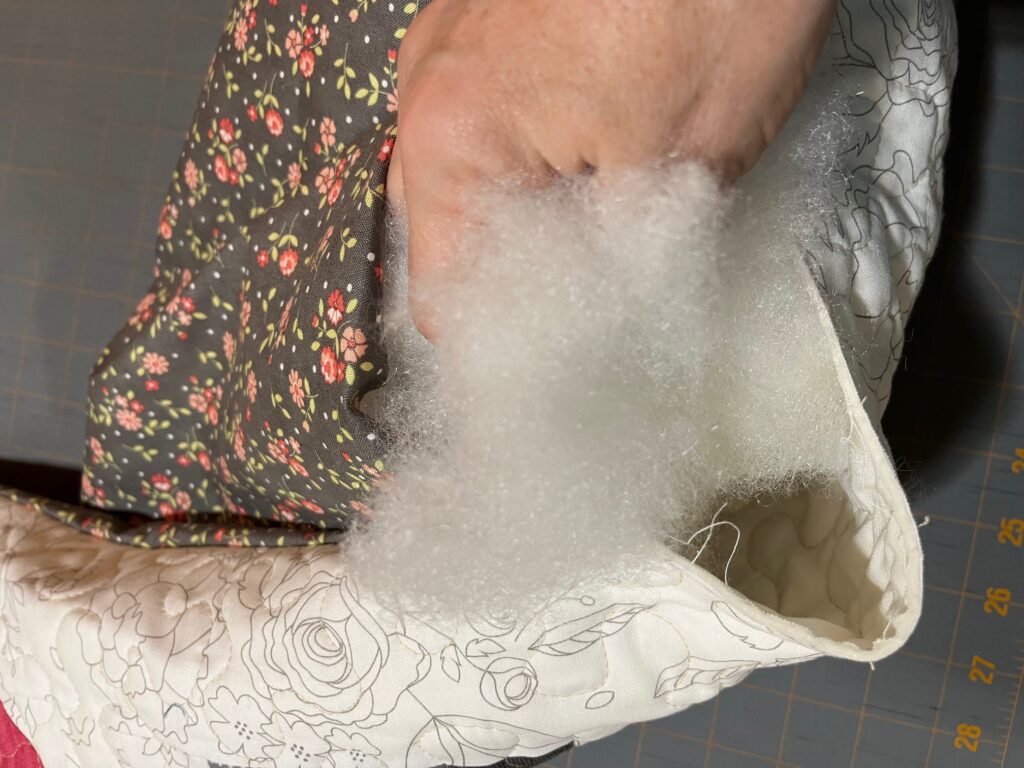
Turn the opening under and hand stitch the opening closed using a needle and thread and small stitches.



Voila! You have a beautiful Valentine’s Day or any day pillow to decorate your bed or furniture!


Finish the Mini Quilt or Wall Hanging
If you choose to make a mini quilt instead of a pillow here is how you’ll finish it with binding.
Binding the Quilt
When you’ve finished quilting the layers together, it’s time to bind them!
Prepare the Binding
Fold each of the cut binding strips in half end to end. Use the 45° line on your plastic ruler to trim the ends at a 45° angle.
When you open the strips the angles on the ends will be facing in opposite directions.
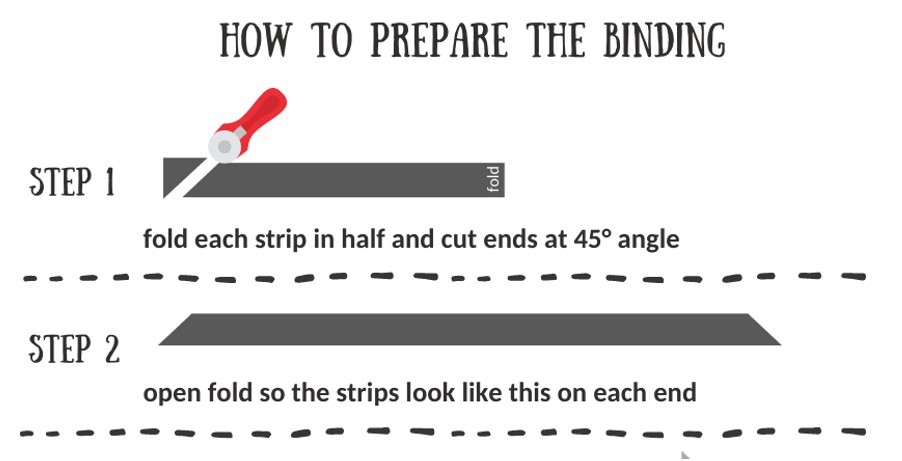
Place the ends of two strips perpendicular, right sides together, and sew 1/4″ seam.
Repeat to join all strips into one long binding strip. Press seams open, then press long strip in half lengthwise, right sides facing out.
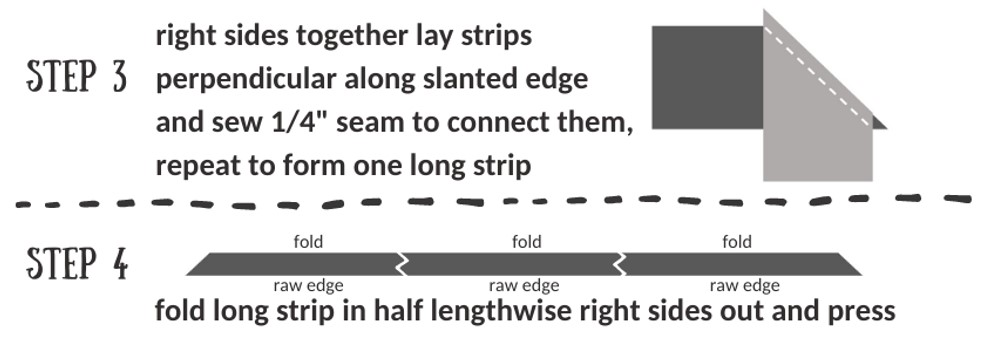
Sew the Binding Strip to the Quilt
Begin to sew the raw edge of the binding to the quilt by pinning it along the bottom side. Be careful to sew the raw edge of the binding strip to the quilt, not the folded edge!
For a quilt this size I usually start sewing the binding strip about 2” from the first corner I’ll miter. Start sewing about 8” in from the end of the binding strip, leaving a hanging tail #1 on the binding. You’ll sew this to the other end of the binding strip (tail #2) when you finish sewing all along the sides of the quilt.
Stop sewing on the first side 1/4″ from the corner, use a pin to mark this location and sew right up to it. Backstitch a bit, and cut your thread but DON’T cut the binding strip.
Making the Mitered Corner
Now, remove the quilt and binding strip from your machine and fold the binding strip straight up so it’s perpendicular from the side you were just sewing on.
Fold the binding strip back down on itself and match it to the edge of the quilt you just sewed it to, and the next edge of the quilt you’re about to sew it to. Pin this fold in place, and pin the binding strip to this edge of the quilt and continue to sew it, again stopping 1/4″ from the next corner and repeating the folding process described above.
Continue in this manner until you are on the last side of the quilt, the side you started on.
Connecting the Ends of the Binding
Stop stitching about 12” from where you started. Backstitch and cut the thread (but not the binding strip, not yet!), remove the quilt and binding strip from the machine.
You now have two “tails” of the binding strip, tail #1 from where you started stitching it to the quilt and tail #2 from where you ended. You’ll need to join these tails together so that you have a continuous binding strip to finish sewing down to the quilt. Follow the steps below to join the tails!
STEP 1
Lay tail #1 of the binding strip along the unsewn edge of the quilt. Trim it at a 90° angle about half way between this unsewn edge.
STEP 2
Lay tail #2 of the binding strip over tail #1 along the unsewn edge of the quilt. Measure 2 1/2″ beyond the trimmed straight edge of tail #1. Mark this 2 1/2″ measurement with a pin or pencil, and trim the tail #2 at a 90° angle also. The two trimmed binding strip tails should overlap by 2 1/2″.
STEP 3
Unfold the two tails so they lay flat. Pin the two tails together perpendicular to each other (right sides together). Use a fine pencil to draw a diagonal line from the corner of tail #2 to the opposite side, as shown here.
Sew along the drawn diagonal line. Fold binding strip in half again. The continuous binding strip should now lay flat along the unsewn edge of the quilt. If necessary, shorten or lengthen the continuous strip before trimming it. Then trim the outside corner 1/4″ from the seam and finger press the seam open. Fold it in half again and finish sewing the binding strip to the quilt.

Trim the Batting and Back
Trim the batting and quilt back to 1/4″ from the edge of the quilt top. I use a ruler and a rotary cutter to accomplish this task. Work carefully, so you don’t cut into your quilted project.
Hand-Stitch the Folded Binding Edge to the Quilt Back
Here is my FAVORITE part of the process, hand-stitch the folded edge of the binding strip to the back of the quilt. When you get to the corner, carefully turn the corner right-side out to make a nice, mitered corner. I tack a few stitches up the corner to hold it in place, and then continue stitching along all sides and corners until…VOILA! Your binding is complete!
If you’d like, you can add a label to the back of your quilt.
There you have it! Directions for making the Pillow Talk throw pillow or mini quilt!!
If you’ve enjoyed this pattern check out some of my other patterns like my Granny Love or Sweet Pea quilt patterns!
Happy Quilting!!


